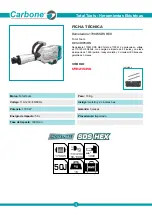
Electric Jackhammer
2
Stay alert. Watch what you are doing. Use common sense. Do not operate the tool when you are tired.
Check damaged parts. Before further use of the tool, a guard or other part that is damaged should be
carefully checked to determine that it will operate properly and perform its intended function. Check for
alignment of moving parts, binding of moving parts, breakage of parts, mounting, and any other conditions
that may affect its operation. A guard or other part that is damaged should be properly repaired or replaced
by an authorised service centre, unless otherwise indicated elsewhere in this instruction manual. Have
defective switches replaced by an authorised service centre. Do not use the tool if the switch does not turn
on and/or off.
Do not use power tools for applications other than those specified in the instructions of this manual.
To ensure the designed operational integrity of power tools, do not remove installed covers or screws.
Do not touch movable parts or accessories unless the power source has been disconnected.
Use your tool at a lower input than what is specified on the nameplate; otherwise, the finish may be
damaged and working efficiency reduced due to motor overload.
Do not wipe plastic parts with solvent. Solvents such as gasoline, thinner, benzene, carbon tetrachloride,
alcohol, ammonia and oil containing chloric acid may damage and crack plastic parts. Do not wipe them with
such solvents. Wipe plastic parts with a soft cloth lightly dampened with soapy water.
Consult an authorised service agent or centre in the event of a power tool failure.
Precautions When Using the Jackhammer
Wear protective glasses to protect your eyes.
Wear a mask when turning your head upwards.
Use earplugs to keep your ears noise-free while working.
Set the bit holder properly.
Since the bit becomes very hot during operation, exercise extreme caution when you are near it.
Be sure to use the side handle.
Safe operation depends on one’s stable posture.
At the start of each work, check the oil supply and tighten any loose screws.
When working at a highly elevated location, pay attention to objects and persons that are below you.
Before starting to break or chip a wall, floor, or ceiling, confirm thoroughly that no items such as electric
cables or conduits are buried inside.
Wear protective shoes to protect your feet.






























